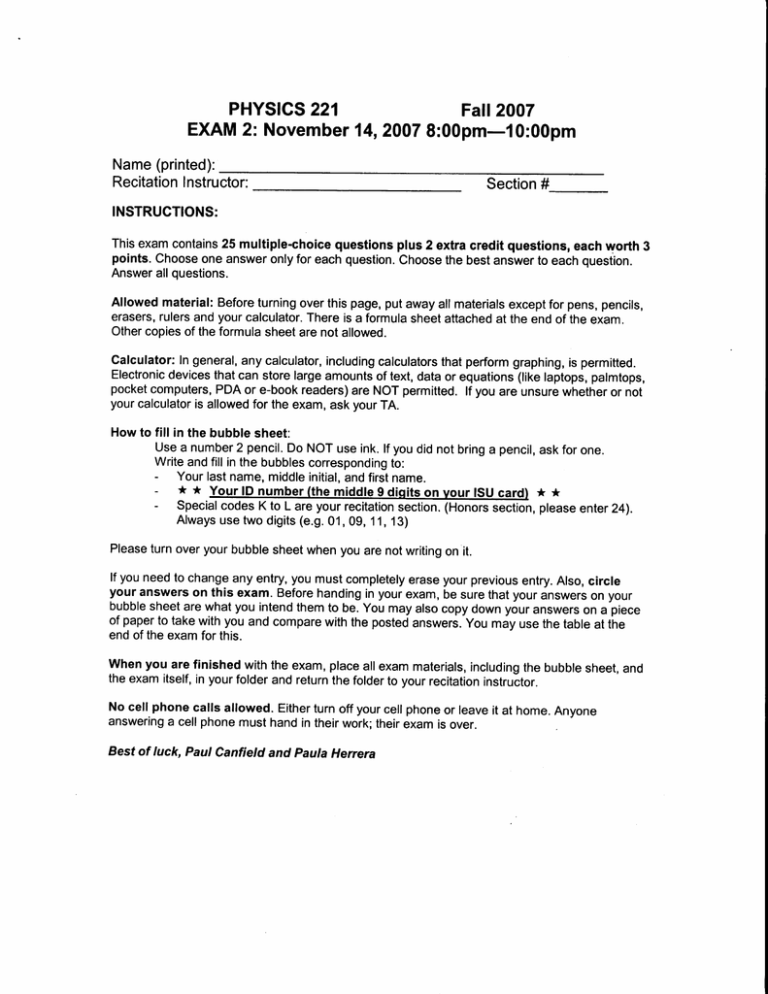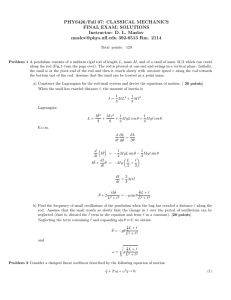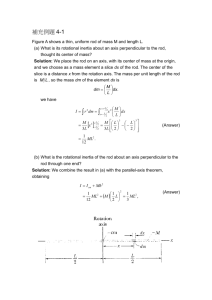PHYSTCS 221 Fall 2007 EXAM 2: November
advertisement

PHYSTCS
221
Fall 2007
EXAM2: November14,20078:00pm-10:00pm
Name(printed):
Recitation
Instructor:
Section#
INSTRUCTIONS:
Thisexam contalns25 multiple-choicequestions plus 2 extracredit questions, each worth 3
points. Chooseone answer only for each question.Choosethe best answerto each question.
Answerall questions.
Allowed material:Beforeturningover this page,put away all materialsexceptfor pens,pencils,
erasers,rulersand your calculator.There is a formulasheetattachedat the end of the exam.
Othercopiesof the formulasheet are not allowed.
Galculator:In general,any calculator,includingcalculatorsthat performgraphing,is permitted.
Electronic
devicesthat can storelargeamountsof text,data or equations(likelaptops,palmtops,
pocketcomputers,PDA or e-book readers)are NOT permitted. lf you are unsurewhetheror not
your calculatoris allowedfor the exam, ask your TA.
How to fill in the bubble sheet:
Use a number2 pencil.Do NOT use ink. lf you did not bringa pencil,ask for one.
Writeand fill in the bubblescorresponding
to:
- Your last name,middleinitial,and firstname.
* * Your lD number (the middle 9 diqits on vour ISU cardl * *
- Specialcodes K to L are your recitationsection.(Honorssection,pleaseenter24).
Alwaysuse two digits(e.9.01, 09, 11, 13)
Pleaseturn over your bubbtesheetwhen you are not writingon it.
lf you needto changeany entry,you must completelyeraseyour previousentry.Also,circle
your answers on this exam. Beforehandingin yourexam,be sure that your answerson your
bubblesheetare what you intendthem to be. You may also copy down your answerson a piece
of paperto take with you and comparewith the postedanswers.You miy use the table at the
end of the examfor this.
When you are finished with the exam,placeall exam materials,includingthe bubblesheet,and
the exam itself,in your folder and returnthe folderto your recitationinstruitor.
No cell phone calls allowed. Eitherturn off yourcell phoneor leaveit at home.Anyone
answeringa cell phonemust hand in theirwork;theirexam is over.
Besf of luck, Paul Canfield and paula Herrera
28. Which of the following changesto an oscillating systemwill causethe smallest
changein the system'speriod?
A) For a spring / mass system,double thq mass.
B) For a spring / mass system,double the spring constant.
a simple pendulum (point masson a string), double the length of the string.
$For
'p)/For
a simple pendulum (point masson a string), double the mass.
All
of
the above changesaffect the period in the samemanner.
D
-Tr
t
29. An insulatingrod with chargeQ is placedat distanced froman uncharged
metal
surface.The electrostatic
forcebetweentherodsis:
A) Zero.
B) Attractiveit Q > 0, repulsiveif e < A.
(
A Attractive if Q 0, repulsiveif Q > 0.
(92Attractive, independently
of the signof e.
E) Repulsive,independently
of the signof e.
--fl*.
{-Dd Jot-*t *es tl^o cneM
't,
b-t
1
/-( -
a")tlrfurL
8)o
\
)
8,c 1\^*k
tt.-
rDJ
ov f\*sde \)
.UtLvg
'..^
lt^c
Trr
It
+
*+
,.,'
3 0 . Fourforcesof equalmagnitudeF anddifferentdirectionsareappliedat different
pointson a rod of lengthL asshownbelow.All the forcesarein the planeof this
page.Whatis the magnitudeof the net torqueaboutpoint P?
A) 0.r3FL
,3tr0.s0rz
E) r.zFL
Lt2
L
\ - a
7
o
(e
{)
c
= o,63rL
3 I . An insulating,rod is balancedat its centerof massand is allowed to rotate in the
horizontalplane, that we shall take as the xy plane. It has a positive chargeon one
end of the rod and an equally sized,negativechargeon the other end of the rod.
Taking the pivot as the origin, the positive end is located at (x, y) : (0, I ) and the
negativeend is locatedat (0, -l). For which directionwill an appliedfield, of
magnitude1000N/C, result in the largestpotential energy of the system?
A) Along the x axis, pointing in the positive direction
B) Along the x axis, pointing in the negativedirection
;Q Along the y axis, pointing in the positive direction
(!t Along they axis, pointing in the negativedirection
E) Along the direction of the vector that runs from the origin to the ( I ,l point.
)
/\d
l,\
t.:,t
rrJ
U:
D,D
t
LJr"ox t{U^^
-1
>x
t
clre
F *^J
*hF'tILl
"l^'rci.r.\^
32. Two particles of masses m and2m move toward one another with speedsv and2v,
respectively,and collide. After the collision, they come out at a 45" angle as shown
in the figure.
6
lt^
,1,
u'Y
,,,
What is the speedof the centerof massof the systemafter the collision?
5
A ) v
J
)
B)' -::v
a
I.r
vv tlz
( c)/v
555553v
E) J'"
-R^$- retsw\
S
t\*-
e u J \ " l ' t J i l g(\ ^ t r * k =
i
vftY et*o.qe r../r
{u
D),>.)
lnn\r-?s-n.2,{T -
r l u i .i A
\
t
l-
u
'
I
rrv
33. Two charges+q and-3q areplaced on the x-axis as shown. L (left), M (middle) and
R (right) refer to the points along the x axis that are to the left of q, betweenthe two
charges,and to the right of -3q, respectively.
3
*
=_ > ' ,
*'.61
G
4
€ - q o" T
The net electric field is of course zeroat infinity, but there might be other points
along the x axis where the net electric field is zero, too. In which region(s)?
.4.
( AD In regionL
Y) In regionR
C) In regionsL andR (therearetwo pointswhereE: 0)
D) In regionM
E) Thenet electricfield is neverzeroon thex axis(exceptat + o)
T.6\"^fu FW")
L oJ A"
LI4n
c^^rLrujtfilffi,u*
/n-
r
F
I
$"rt t -
- . \o141611ro
G\r.
I L . q - clr^r=trq, l,(nh- qil.r-16,
tn e,
nn q.''.f,.rJ
, /q L- / (.^ntez"-i tr*ors
u c(s)c;I [O €' q ) Ftr' crJ;;.Drt<-l
o C4 = 1
AsLt,{'lx 6 irot/ t^'tna,i
34. A point chargeQisatthe centerof a sphericalmetal shell of radii R and 2R. The
shell has a net charge-3 Q.The chargeon the inner surfaceof the shell is:
q
A)
2g
-a
0
D)
E) 2Q
a
?-+Q
-
4- o
,$oU
\
)
i
?,n
s -q
kgandradius1.15x 103km. If a 0.5-kgrockis
of mass1.31x 1022
35. plutois a sphere
from a heightof 10m abovethe surfaceof Pluto,how long will therock
released
taketo hit the ground?
A) 1.4s
B) 2.2s
C) 4.2s
(4 5.5s
Y)
6.7s
36. A proposedlow-budget carnival ride consistsof a cabin hung from a vertical spring
"shakes"the passengersin the cabin with harmonic oscillations (seefigure). The
that
combinedmassof the cabinsand the passengersis 1000kg, and the spring constant
is 6000 N/m. For safety reasons,the accelerationof the passengersshould never
exceed3S @:9.8t m/s2).What is the maximum amplitudeof the oscillations?
A) 1.6m
A) 3.3m
4em
C 9 6.5
m
D)
E) 8.0m
&u^y= AuF
.-1
L,D-=
At,t
cn
A ?
< %
I
LL
rn
3ry
T:
*?n
37. A non-uniform rod of mass2.0 kg and length 2.0 m can rotate freely about an axis
through a point P that is 1.0 m away from the centerof massof the rod. The rod is
releasedfrom the horizontal position. When the rod is vertical, the angular speedof
the rod is 3.0 radls. What is the moment of inertia of the rod about point P?
A)
B)
C)
D)
0.67kg -t
2.2kgmz
2.7 kgmz
3.6ke m2
@o oki-'
csrulVrilIru
€"Rt'41
V \
O +
-'$J :
L4,**o
\
+
93' : q.+kf*_
()JL
38. A cylinder is releasedfrom the top of an incline and rolls down without slipping.
Which of the following statementsaboutthe friction force betweenthe cylinder and
the incline is true?
A) There is no friction.
B) The friction is kinetic and points up along the incline.
C) The friction is kinetic and points down along the incline.
@) The friction is static and points up along the incline.
Y) The friction is static and points down along the incline.
ql*Tf..b
gfrn"- tmtn^'s'fh r6U1. anr"ll^puf
efrIr' k
T*nF
d,s&, r,tel- nrl$\t- nd^ilrr'e
rocL-ru-
\lP
t+ Te^"b
\_*
{t$-
Wc-o,t;>u
l
\
c-1knd.c-r 4,IIAJ\d,
n\o,anl
tul
l,-
+D \ t\A.+1
[t-. 1f"o qlz:rcncq- { -f* .]- $\'\
KUe*- d^$-;;o) t^s[.icl^-L-D\J$
c.r?a\e- dar,orr
)
39. Considertheorbitsof the planetsin thesolarsystem.Whichof the following
quantitiesis NOT constantthroughoutthe orbit?
A) Mechanicalenergy
Ct\A"gular speed
)fangular momentumaboutthe sun.
D) Noneof the quantitiesaboveareconstant.
E) All the quantitiesaboveareconstant.
6,f5"1-c^Sqxf J
b
o(t'en"G
c{c*io"/
C.slu',\a,,"}ul-.t*. k,
lI "
40. A 50 g beadis in equilibrium at the end of a springwith k: 2.5 N/m. At t -0, the
beadis pulled 0.30 m and released.A dampingforce F - -bi actson the bead,and
the amplitudeof the motion decreases
to 0.10 m in 5.0 s. Find the magnitudeof the
dampingconstantb.
,l^
kds
e) 0.022
B) 0.45kg/s
C) 1.7kg/s
D) 8.2kg/s
E) 38 kg/s
L
At+rz d*e hv
/
|
*
D
2
2}n l^
- . u I
+
Ao-
-
:
A
-
r
\
^( o,oqj L^) ,
nOr
o ,e^) c':l
o.,tDn-
of radii 11: R, 12:
41. A pointchargee> 0 is at thecenterof threeconcentric'spheres
the
ZR andrt: 4R.Therearenof otherchargesnearby.Whatis the relationbetween
(6r is the flux throughthe ithsphere).
electricfluxesthroughthese'spheres?
@ t: 2 Q z : 4 Q t
@ t: 4 @ z : l 6 , t
l6h - 4Qz: Qt
4 @ t: 2 Q z : ( D t
of the above.
@None
A)
B)
C)
Di
T
T
A
O
=
9, f,a 9g: €
42. A uniform rod of massm andlengthI has two small spheresof massm attachedto
the ends.The systemrotateswith initial speeda.rsin the horizontal plane, about the
centerof the rod. Suddenly,both spheresdetachand drop from the rod. What is the
angularspeedof the rod right after the spheresdrop?
A) cosl7
B\ 2ool5
6>o
saolz
Y)
E)7ao
l1^o- qLiueg
cte-hd'J*-tLe--F
G;,q +ric.\lr^
erF.-Tt.r- rpd , so
U
;o nM
\
d4zcftc
L!
v
,ls
mfrja-lr
43. The figure below is made of eight uniform squaresof side a. Find the x component
of the centerof mass.
v
(
o
{D
A ' ) a4
B ) a
J
'f^)
| (-. I
la
| -
\J2
D)
2a
J
ra\
L I'
3a
4
-(/w b.^ A
tu1- *tL-
8
juv\Lo \*"V iF'f
)
n 4' - L'Js.tL 1t^1 3 ob1*.l,
ffin\€J
I
X c t , na
2n!-o.) * z-(o)*
\.,/
crn
abuw
,frrJ
,n-.=L
tf*l'Eo)
E, L
-)
L
44. Below, the momentum vectorsof two objectsare shown before and after a collision
on a frictionlessair table. Which of the figuresbelow is not physically possible?
*i*^-{=.-+
\
\-
F
n\
'.J:
'
-
t
n
'
k
.
,
-.
f-
P
l
t
|
tn"o
f
c
g
c-
t
tt-o
4v
fr
;*
t-\
-
r
p
T!*
s
r
s
/
d
,n,h,*O
h
oU
|
r ko
*
4
cim rrwirtuv.^
I
f'ryg!
\r* n"e- Y d*leClrrn-\
n
Lqr.
/-\..,-M ^A-^
\,
CtDanq,n+.J\^"
l'x
45. Treat the orbits of Earth and Mercury as essentiallycircular. A spacecraftis in an
orbit about the Sun with the perihelion point at the orbit of Mercury and the aphelion
point at the orbit of the Earth. Calculatethe flight time for the spacecraftto travel
from Earth orbit to Mercury orbit. (The radius of Mercury's orbit is 5.6 x 1010m and
the radiusof Earth's orbit is 1.5 x l0ll m. The massesof Mercury, Earth and the
Sun are 3.30 x 1023kg,5.97 x l02akg, and I.gg x 1030kg respectively.)
Y^M{ne : ae-
A) 365 days
II 208days
Gl)to4 days
Yt 88.0days
E) 27.3days
cnrilrL"-l*'rrts = T
-, I
= { -
?-
z-tta1L
Z* \)GMs,n
46. A 2.00 m long rod with a massof 15.0kg is attachedto the left wall by a hinge. It is
supportedon the other end by a masslessstring attachedto the right wall. If the
strlng makesan angle of 37.0 degreeswith the wall, what is the tension in the string
if the rod is horizontal and motionless?
A) 46.0N
b31:3N
ttf r22N
E) 147N
tOtLu.lV
I
-L
a
|
\_4\
A/4hrf
I h{
t
h, n g(- "
LTexr3}o
^^th
= C)
e' = n2 cN)
2cnB+
47. The sketchbelow shows four identicalmassesattachedby masslessrods to form a
rectangleof dimensions2L x L. For which axis of rotation will this rectangular
object have the smallestrotational moment of inertia,/?
$)
n)
I z*rrf-- ?nnf
Llnnt-7
I
t
I
t-
E)
I
tn*r,axr
C.€lnr-&- $F
I
Rqc'il+r:"tt'
1
I
i-I _
I
-,b{s
L
Axts arTcF
II
{
r
L . L t
'Jt*tz)
I
q
']-
,
^
.,,,,.,..
rl
l
u
L{-'A>
I
I
I
I
r
\'?-
tcn
1-
+t ta-r,t*\,z/ )Y l = c r t L
(b{"f
\.-
6mL
48. An electronwith speedof 5.00 x 108cm/s entersan electricfield of magnitude
I .00 x 103N/C, traveling along the field lines, as shown below. If the region with the
electricfield is 1.50cm long, what is the electron'sspeedwhen it emergesfrom this
region?
*)
E
-+l
A) 5.00 x 108cm/s
@i+.+4xro8cm/s
tf 3.33x lo8cm/s
D) 2.22 x 108cm/s
E) 0 cm/s
*--+
e
V
W :
lJ:
.Ir i'
q
_*+i
--+l
*----*l
=l
=l
1.5q)
me
<../w\
s7-
lSl
I
\O
cn
\€€,
., \
nneftr
6"t,\u )
Jh--,e- I
49. A thin rod, one meter in length and with a massof 100 g, is rotated about an axis
locatedat one end. The rod is initially at rest. If a force of 15 N is applied
perpendicularto the far edgeof the rod (initiallypointing into the page),what is the
magnitudeof the rod's angularvelocity 3.0 secondslater?
7a= aq
Fl =f3**)o<
A) 45.0s-r
B) 135s-r
G\ 450s-'
@)r35os{
E) 5400s-'
I
l
,
.%
T-r€)F
7
I
?r
I
I
I
2^EL
c/t
=
u\
-
I
n
nl
\'l lts
(ll :
r
I
.^1
{a
t
L
I
=
cn>
I
F = t6N)
cn: Ol V$.
t =3 , O r
.
[= I cn
o
50. A 0.400kg iron massslidesdown a frictionlessincline, as shown. At the bottom of
the incline the iron masssticksto a 3.00 kg plasticmass,initially at rest,and the
combinedmassslideson a horizontalfrictionlesssurface. The velocitv of this
combinedmassis:
^n
{\A))0.466mts
H o.qg2mls
C) 1.36m/s
D) 3.96mls
E) Noneof the above
finoco af T& dorn
1r"o t-"tiruq-'
*
t
$-:
^ 4 +
lrbn ., ' lqt)"
CYltro.-' t^
- l f
Cna[J
'r v
v r(?Th
(
1
\_/
.
i*d
\t(Dn
\v
1
t
:
rYw\lnr
w
ol*fur
qq\
7 , q %@
2 crr66*h
forcethata 3.00kg mass,with an initial
5I . Thegraphbelowshowsthetime dependent
If the forceis in
(l:0 sf velocityof 5.00m/sin thepositivexdirection,experiences.
thepositivex direction,whatis themass'svelocityat t 1.00s?
n
Qyl3.3 m/s
B) 15.0mis
C) 24.4mls
D) 35.0m/s
E) 50.0m/s
Z:p
1
[rc
r{NJ
qreor
tt^si
N)
:=
\( Eoox\o"%\(ioo
: ZS rr./s
4l
cn
q =qt
CI
---
z{Us
f
-I
bh
? to-3 "^1,
52. Let's look at two spring/masssystems.In system1, a massMr is hung from a
vertical spring. In system2, an identical,verticalspringhas a massMz:2M1hung
from it. The resonantfrequenciesof thesesystemsarefl andfz, respectively.What is
the ratio betweenthe two resonantfrequencies,fl:f2?
-T..A
A)2
B) U2
r6tJz
)dulz.
E) None of the above
oft
fre;a#i'U'tu7
r l
i1o**.J
tt
ffi"al
$5tr".tnc^E-,
eplvrr,
/ \E
{
\J;
-tJ-""
JL
+,
\\ t(
:*
Vn'-
\' l4
U rrlL
t--
\"T
\ frr?
V* ,
-'
u2-
\\^a-
Tt-a
53. A 300 g massis attachedto a string that is wrappedarounda pulley. The pulley has
a radius of 20 cm and the string unwinds from the pulley without slipping. If the
massaccelerates
downwardwith a:7 .77 m/s2,whatis the rotationalmomentof
inertia, I, of the pulley?
$
2.00 x l0-3kg-*'
tl-*t
6@3.r4xro-3
C) 4.00 x 10-3kg--'
D) 1.26x 10-2kg-m'
E) 2.00 x l0-2kg-*t
-T= Mo.
MM1
\
J TR -_ A_u
\
r
I
I
I
I
I
t
t
(la f?"x
:
gs
R.3
4
K-
\-
: f\,ta*
Md(+-r)
T.
-7
54. A solid, uniform spherewith a radiusof 30.0 cm and a massof 4.00 kg is hung so
that it rotatesabout a point on its edge. What is the period of the sphere'smotion if
it oscillateswith a small amplitude?
A) 0.695s
@ t.3os
C) 6.95s
D) 9.45s
E ) 1 3 . 0s
"f1,e.*^0 T.&hr'"^
-
-T=
r-rF-
: i l l
7T
?I
ite
rg
I
d= P--
a:
-ts
b) t d *
=-
^?
n n ? L =Trrilc

